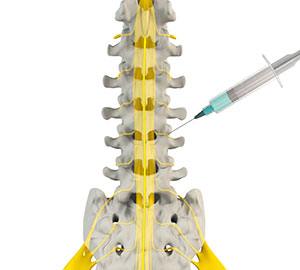
What are Lumbar Medial Branch Blocks?
A medial branch block is a procedure in which a mixture of a local anesthetic with or without a corticosteroid is injected near the medial branch nerves supplying a facet joint. A lumbar medial branch block prevents the transmission of pain signals from the lower back.
Facet joints are paired joints located at the back of the spine, which connect the adjacent vertebrae together and provide stability to the spine. The facet joints in the lower back are referred to as the lumbar facet joints. The medial branch nerves carry pain signals from the facet joints to the spinal cord and brain.
Indications for Lumbar Medial Branch Blocks
Lumbar medial branch blocks are usually indicated if you have lower back pain originating from arthritic changes in the facet joints or from mechanical stress to the lower back.
A lumbar medial branch block can be performed for both diagnosis (to locate the region of pain) and treatment.
Procedure for a Lumbar Medial Branch Block
- To prepare for the injection procedure, you will be placed on your stomach on the X-ray table.
- Your physician will clean the intended site in your lower back with an antiseptic and cover it with a sterile drape.
- A local anesthetic is then used to numb the skin. You may feel a stinging or burning sensation for a few seconds.
- Under live X-ray (fluoroscopy) guidance, a needle is directed near the facet joint to target the medial branch nerve supplying the area.
- Following this, a local anesthetic with or without steroid medication will be slowly injected through the needle.
- The needle is then removed and a bandage is used to cover the injection site.
What will I Experience Following a Lumbar Medial Branch Block?
Your pain may improve immediately after the injection due to the local anesthetic. When steroids are used, it usually takes about 2 or 3 days for the steroid medication to take effect and about 2 weeks to reach the peak effect.
You may experience localized pain around the injection site, for which ice packs can be applied to ease the discomfort. You may experience numbness and increased pain for a few days after the injection. If you are diabetic, there may be a temporary rise in your blood sugar level.
Post-procedure Instructions for a Lumbar Medial Branch Block
You should arrange for someone to drive you home after the procedure. Avoid swimming or soaking in a tub, pool or Jacuzzi and the use of any form of heat to the injection site for the rest of the day following your procedure.
You should keep a record of the degree of pain relief and its duration for your physician to review.
Risks Associated with a Lumbar Medial Branch Block
The possible risks associated with a cervical medial branch block include:
- Bleeding
- Infection
- Allergic reaction
- Damage to the nerves
Call your doctor immediately if you experience:
- Severe pain
- Leg numbness or weakness
- Signs of infection at the injection site
- Epidural Steroid Injections
- Facet Injections
- Medial Branch Blocks
- Radiofrequency Ablation/Rhizotomy
- Peripheral Nerve StimulationTrial & Implant
- Sacroiliac Joint Injections
- Spinal Cord Stimulator
- Peripheral Nerve Stimulation
- Joint Injections (Hip, Knee, Shoulder, Elbow)
- Trigger Point Injection
- Stellate Ganglion Block
- Lumbar Sympathetic Block
- Celiac Plexus Block
- Superior Hypogastric Plexus Block
- Ganglion Impar Injection
- Stem Cell Injections
- Platelet-Rich Plasma (PRP) Injection
- Botox Injections
